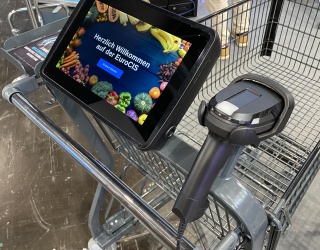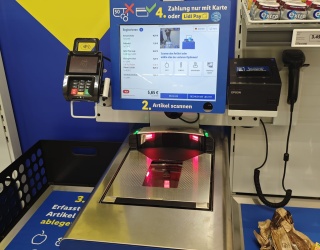Taking inventory is a horror for some retailers. What are the most common problems?
Problems are the considerable effort in preparation, intake and post-processing. The retailer needs to count and document his entire merchandise and assess it on a value and quantity basis. The time and money factors are the ones that put pressure on the retailer and distract him from his main daily business. The valuation of inventory often takes place by markup cancellation of the sales price, which generally results in inaccuracies. Quite frequent are counting errors, which happen when inventory in part is not recorded due to multi-placement – for instance on the sales floor and in the warehouse. Oftentimes the results are not available until weeks after inventory was taken. Differences can rarely be resolved, if the individual transactions date back months ago.
How can the tedious duty of taking inventory turn into an opportunity for a company?
An inventory is commercially crucial for a retailer, since he gets an exact overview of the amount of capital that’s tied up in merchandise. Inventory differences, particularly losses, directly impact earnings – meaning the profit margin – of the company or the store and minimize the already small margins of individual goods. This has a direct impact on the investment potential or- to put it in a negative way- on the profitability of the retail space. Via inventory results, the merchant always receives feedback on the strengths and weaknesses of his own commercial activities and organization. If the retailer has his inventory “under control“, i.e. he carries the right items, in the right amount and at the right time, he optimizes his ability to sell. Surplus is eliminated as well as empty shelves. An optimal inventory level results in an increase of turnover and improvement in the overall result! Exact article-specific inventory offers a chance to resolve losses early and avoid them in the future.
“Closed for Inventory. “ Is this still necessary today?
Of course you can take inventory outside the shopping hours. However, this will incur additional time and cost efforts. For an annual inventory, with its inventory management system, DEWAS Superdata has designed a system which allows for taking inventory over several days. Thanks to the exact allocation of inventory and sales and of course all other transactions it is possible to take inventory during this time period without stress and at different times. The inventory is taken in category groups, which can be audited on their own. This produces a high reliability of results. After completion, the valuation can take place the same day at purchase price.
What’s the advantage of permanent inventory?
Taking permanent inventory is regulated in § 241, section 2 of the Handelsgesetzbuch (The German Commercial Code). It enables retailers to distribute the individual inventory activities throughout the whole year. This means there is no specific inventory due date. The benefits are obvious: overtime and extra staff from employment agencies are not needed. The inventory count can be done during normal working hours and during business hours and slow times and in manageable increments. That way, inventory taking provides daily control over stock, at the same time shelves are being monitored and discrepancies due to theft and breakage/spoilage can be immediately recorded.
What requirements must be met for permanent inventory?
A coherent supply chain from goods receiving to sales as well as a precise inventory management is a prerequisite. Sales based on product groups or by manually entering a price should be avoided as much as possible by using modern scanner-checkout counters at the POS. The use of wireless mobile data acquisition devices is recommended here. The employee is available for customer service and sales assistance at the sales floor during the inventory count. The captured data is conveyed in real time to the inventory management system. Additional processes, which in the past were controlled by the back office computer, can also be run: label printing, price changes, ordering and goods receiving (for example from a third-party order vendor).
What is controlled permanent inventory?
Daily controlled permanent inventory or at specified days of the week releases a selected allotment of items to be counted, which need to be counted and entered in the system. The system complies with legal and organizational specifications. The inventory count can occur at any time during opening hours, if inventory is booked online as is the case with DEWAS. Differences are therefore detectable in real-time and can be immediately resolved.
The inventory count procedure can be optimized to a point where the employee receives a recommendation on the optimal way to organize a shelf. In addition, items are also suggested for a count, which are located in close proximity in terms of area and theme. But at first you need to establish a coherent organization of all goods movements with a functioning inventory management. Superdata created the controlled permanent inventory in such a way, where a maximum effect in terms of accuracy, personnel expenditure and control is achieved. It makes sure that all articles are counted over the course of the year, but the “critical“ items are counted more frequently.
How widespread are MDE (mobile data acquisition) devices in retail?
Almost 90 percent of our customers use MDE devices for data acquisition. These are predominantly wireless MDE devices, which instantly record the received items. The connection takes place via proprietary networks or via WLAN. For the controlled permanent inventory we recommend a wireless link to inventory management, since the employee at the shelf immediately identifies differences while taking inventory and the collected data is directly entered online.
Are smartphones becoming a competitor for MDE devices in inventory taking and inventory management “on the sales floor“?
A prerequisite in the professional area are efficient scanners directly at the device, short response times and high data security in the mobile network. The manufacturers of smartphones currently focus on design. However, the device needs to be robust enough for daily use on the sales floor and in the warehouse. A smartphone with its sleek format that fits perfectly into a shirt pocket is more difficult to find again between articles, under skids or in shelves than a common MDE device. For the future, we see great potential for smartphones in the area of active customer service on the sales floor or as a platform for making inventory management functions available for the merchant.
Merchandise management solutions are getting more and more complex. What additional tools are especially sought after at the moment?
With our addition “RetailMap“ we are able to display retail processes in a user-friendly way. The employee is guided step by step during the process chain, e.g. when ordering articles. Despite being an off-the-shelf addition, it allows for an individualized procedure for a company, which can simply be adapted for modifications. This minimizes training time and provides significantly more process reliability.
What were your top topics at the EuroShop?
We introduced software as a service. “cashPlus@cloud“ is the low priced package for retailers for a POS- and inventory management solution based on a monthly rental fee. There is no large start-up investment and no expenditure of time and work for special IT topics like data protection or hardware failure. Another trade fair topic for us was GDPdU in inventory management. Besides pure cash transactions and billing data, data from inventory management is also “tax relevant“.
Mobile applications were an important topic for many exhibitors, and also for us. Our module for customer management assists the mobile processing of customer orders from entry to delivery order and invoice. The customer order can be done over the phone, via the Internet or via a wireless MDE device at the store per self-scanning. Customer specific discounts e.g. for large customers like nurseries, schools and nursing homes can be considered. This means: improved customer service without burdening the checkout.
Were you happy with the trade fair and the booth visitors?
We were very pleased with the trade fair. We were able to intensify our customer contacts. The numerous talks with prospective new customers will lead to interesting management presentations in the coming weeks.
Interview by René Schellbach, iXtenso.com











